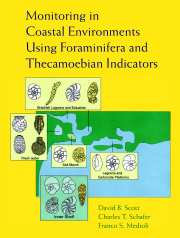Book contents
6 - Conclusions and Final Remarks
Published online by Cambridge University Press: 18 August 2009
Summary
A glossary and some basic taxonomy on all of the species used in this book have been provided, as an appendix, for those readers who want to go a step further. The bibliography is also in the appendix and includes all the text references as well as those only in the taxonomy section of the appendix; this should provide a good literature base for further study.
A variety of applications have been shown here, such as:
Climatic (including sea-level)
Pollution impact, monitoring, mitigation
Seismic activity “fingerprints”
Sediment transport phenomena (tracers)
Storm activity tracers
Paleoproductivity indicators
Classification and characterisation of estuaries
Freshwater–marine transitions
There are also remarks on several other subjects. Biostratigraphy, which is the most widely known of all microfossil applications, has been excluded as it was felt that it has been already documented in great detail elsewhere; the type of applications discussed in this book represent the future of micropaleontology and will likely be the most often used in the coming decades.
It is clear that there are almost as many applications for microfossils as there are environmental problems. The authors have discussed a few examples derived from their own experience, but new types of problems arise almost daily. The readers of this book should consider these examples as just that – examples – whereas the techniques discussed in the book can be applied to any type of problem that may be encountered in aquatic environments.
Information
- Type
- Chapter
- Information
- Publisher: Cambridge University PressPrint publication year: 2001
